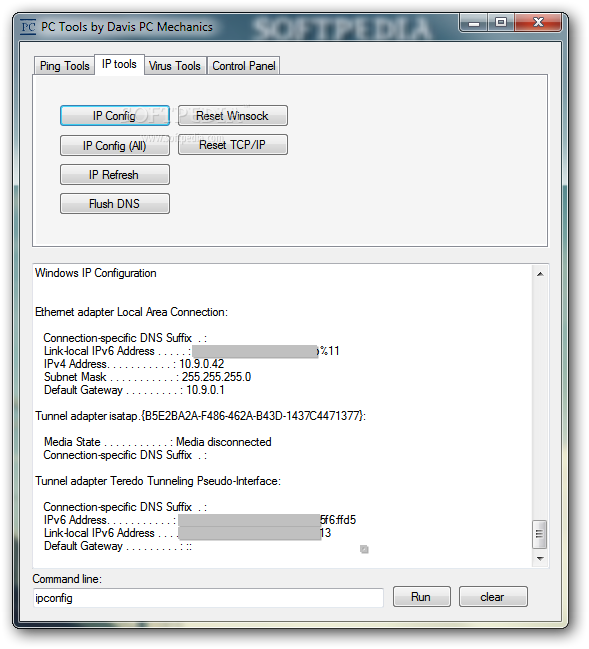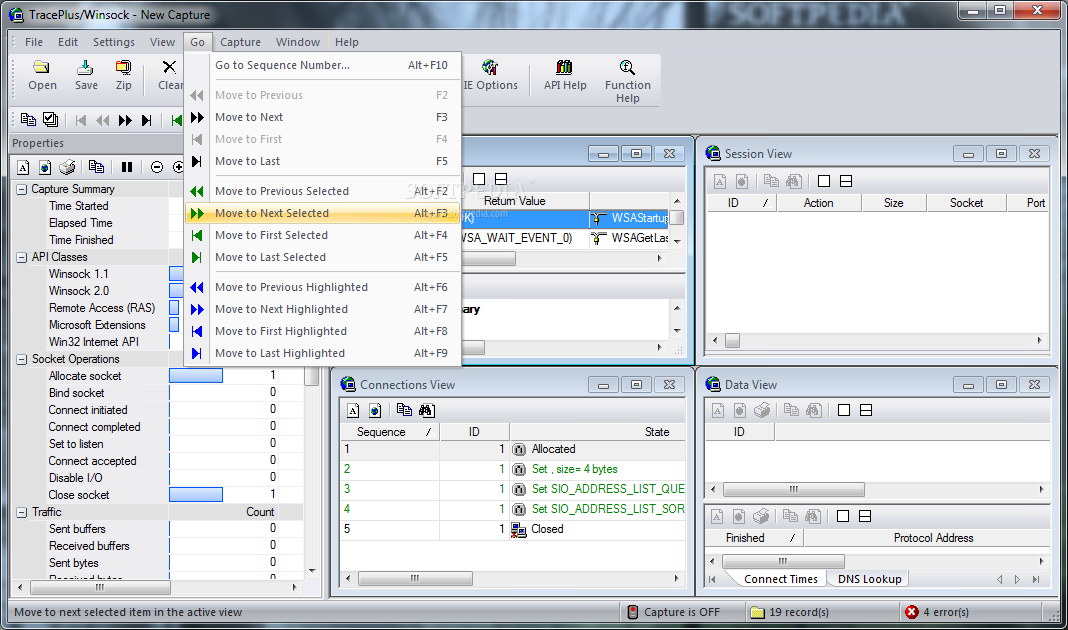Comments. Disabled Adapter Posted by Sweety on 10:24am Thanks for the useful article. Is there any method/command to retrieve the MAC address of the disabled network adapter.

Winsock fix free download - Free Registry Fix, ST101 WinSock, TracePlus Winsock, and many more programs. Drivers Games. Best Video Software for the Mac How To Run MacOS High Sierra. Winsock REXECD/NT is a Remote Exec Daemon for Windows NT, 2000, XP. It services the standard rexec command. It services the standard rexec command. It runs as a Windows Service and will work only under Windows NT, 2000, XP, and 2003.
kernel Posted by kreon on 02:58pm Is this possible to get MAC atd DDK/WDK level in Windows XP?. Posted by Total Commander on 06:12pm You made some good points there. I checked on the web for additional information about the issue and found most people will go along with your views on this site. PrintMACaddress function is not there in Method 3 Posted by Shaurya on 07:26am You have used a function PrintMACaddress in Method but that function has not been defined in your code. Can you give me some pointers how to go about writing the code.
ERROR Posted by Oves Khan on 04:15pm getting error in the calling of the method GetAdaptersInfo it says undefined reference to the function GetAdapterinfo. IPv6 Posted by Ruud van Gaal on 03:48pm With ipv6, GetAdaptersInfo is gradually becoming legacy. For IPV6, you'll need GetAdapterAddresses. brilliant Posted by Sanjeev Kumar on 10:30am very useful thanks for the article. You must have javascript enabled in order to post comments.
Leave a Comment. Your email address will not be published. All fields are required. Name. Email. Title.
Comment.

Contents. Background Early Microsoft operating systems, both MS-DOS and Microsoft Windows, offered limited networking capability, chiefly based on. In particular, Microsoft did not offer support for the TCP/IP protocol stack at that time. A number of university groups and commercial vendors, including the PC/IP group at, FTP Software, and, introduced TCP/IP products for MS-DOS, often as part of a hardware/software bundle. When was released, these vendors were joined by others such as Distinct and in offering TCP/IP for Windows.
The drawback faced by all of these vendors was that each of them used their own API (Application Programming Interface). Without a single standard programming model, it was difficult to persuade independent software developers to create networking applications which would work with any vendor’s underlying TCP/IP implementation.
Add to this the fact that end users were wary of getting locked into a single vendor and it became clear that some standardization was needed. The Windows Sockets API was proposed by Martin Hall of JSB Software (later Stardust Technologies) in a 'BoF' discussion on the network in October 1991. The first edition of the specification was authored by Martin Hall, Mark Towfiq of Microdyne (later ), Geoff Arnold of, and Henry Sanders and of, with assistance from many others. There was some discussion about how best to address the copyright, intellectual property, and potential anti-trust issues, and consideration was given to working through the or establishing a non-profit foundation. In the end, it was decided that the specification would simply be copyrighted by the five authors as (unaffiliated) individuals.
All the participating developers resisted the shortening of the name to simple Winsock for a long timesince there was much confusion among users between the API and the DLL library file (winsock.dll) which only exposed the common WSA interfaces to applications above it. Users would commonly believe that only making sure the file was present on a system would provide full TCP/IP protocol support. Technology The Windows Sockets API specification defines two interfaces: the used by developers, and the, which provides a means for network software developers to add new protocol modules to the system. Each interface represents a contract. The guarantees that a conforming application will function correctly with a conforming protocol implementation from any network software vendor. The contract guarantees that a conforming protocol module may be added to Windows and will thereby be usable by an API-compliant application.

Although these contracts were important when Windows Sockets was first released, since network environments required multi-protocol support (see above) they are now of only academic interest. Included in the Windows Sockets API version 2.0 are functions to use, although the protocol was all but obsolete already at the time WSA 2.0 shipped. Has shipped the protocol stack with all recent versions of Windows, and there are no significant independent alternatives. Nor has there been significant interest in implementing protocols other than TCP/IP. Windows Sockets code and design are based on, but provides additional functionality to allow the API to comply with the regular Windows programming model.
The Windows Sockets API covered almost all the features of the API, but there were some unavoidable obstacles which mostly arose out of fundamental differences between Windows and (though Windows Sockets differed less from than the latter did from ). All function calls in the begin with the WSA, e.g. WSASend for sending data on a connected socket. However it was a design goal of Windows Sockets that it should be relatively easy for developers to port socket-based applications from to Windows. It was not considered sufficient to create an API which was only useful for newly written Windows programs. For this reason, Windows Sockets included a number of elements which were designed to facilitate porting.
For example, applications were able to use the same to record both networking errors and errors detected within functions. Since this was not possible in Windows, Windows Sockets introduced a dedicated function, WSAGetLastError, to retrieve error information. Such mechanisms were helpful, but application porting remained extremely complex. Many original applications had been implemented by using system features specific to, such as and the, and reproducing such functionality in Windows was problematic.
Within a relatively short time, porting gave way to the development of dedicated Windows applications. Specifications.
Windows Drivers For Macbook Pro
Version 1.0 (June 1992) defined the basic operation of Winsock. It was kept very close to the existing interface of Berkeley sockets to simplify porting of existing applications. A few Windows-specific extensions were added, mainly for asynchronous operations with message-based notifications.
Although the document didn't limit support to TCP/IP, TCP and UDP were the only protocols explicitly mentioned. Most vendors only delivered TCP/IP support, although Winsock from included support as well.
Winsock Drivers For Mac
Version 1.1 (January 1993) made many minor corrections and clarifications of the specification. The most significant change was the inclusion of the gethostname function. Winsock 2 was a extension of Winsock 1.1.
It added support for protocol-independent name resolution, asynchronous operations with event-based notifications and completion routines, layered protocol implementations,. It also formalized support for multiple protocols, including. The new specification allowed sockets to be optionally shared between processes, incoming connection requests to be conditionally accepted, and certain operations to be performed on socket groups rather than individual sockets. Although the new specification differed substantially from Winsock 1, it provided source- and binary-level compatibility with the Winsock 1.1 API. One of the lesser known additions was the Service Provider Interface (SPI) API. Versions 2.0.x (May 1994 onwards) had internal draft status, and were not announced as public standards.
Version 2.1.0 (January 1996) was the first public release of the Winsock 2 specification. Version 2.2.0 (May 1996) included many minor corrections, clarifications, and usage recommendations. It was also the first version to remove support for 16-bit Windows applications. Version 2.2.1 (May 1997) and Version 2.2.2 (August 1997) introduced minor functionality enhancements.
Mechanisms were added for querying and receiving notification of changes in network and system configuration. The Technical Preview for (December 2000) saw the first implementation of (March 1999, later obsoleted by ), a protocol-independent API for name resolution, which would become part of Winsock in. Updates in Windows 8 includes the 'RIO' (Registered IO) extensions for Winsock. These extensions are designed to reduce the overhead of the user to kernel mode transition for the network data path and the notification path, but use the rest of the regular Windows TCP and UDP stack (and uses existing network cards).
Windows Drivers For Mac
The setup path (for example, the 'connect' function) is unchanged from the regular Winsock path. Implementations Microsoft implementations. Microsoft did not supply an implementation of Winsock 1.0.
Version 1.1 of Winsock was supplied in an add-on package (called Wolverine) for Windows for Workgroups (code named Snowball). It was an integral component of Windows 95 and from versions 3.5 and onwards (the initial commercially available version of Windows NT, version 3.1, included only a proprietary and quite incomplete implementation of TCP/IP based on the AT&T UNIX System V 'STREAMS' API ). Version 2.1 of Winsock was supplied in an add-on package for Windows 95. It was an integral component of, and all subsequent Windows releases.
(Microsoft did not supply implementations of Winsock 2 for Windows 3.x or Windows NT 3.x.). Recent versions of Winsock 2.x have been delivered with new Windows releases or as part of service packs. Winsock 2 is extensible by a mechanism known as a (LSP). Winsock LSPs are available for a wide range of useful purposes, including Internet parental controls, web content filtering, etc. The layering order of all providers is kept in the Winsock Catalog. In previous versions of Windows, removing a buggy LSP could result in corruption of the Winsock catalog in the registry, potentially resulting in a loss of all network connectivity. Winsock in Windows XP Service Pack 2, Windows Server 2003 Service Pack 1 and all later Windows operating systems has the ability to self-heal after a user uninstalls such an LSP.
Other implementations. Among the other vendors offering Winsock-compliant TCP/IP and UDP/IP stacks were (alphabetically), Beame & Whiteside, DEC, Distinct, Frontier, Microdyne, and Trumpet Software International.
Trumpet Winsock was one of the few Winsock 1.0 implementations that could be installed under, which had no built-in support for Winsock. Trumpet was also the most popular implementation of Winsock for Windows 3.x. Trumpet Winsock 5.0 is available for / and and includes a Winsock 1.1 compliant IPv6 stack for these operating systems. See also. (Winsock LSP) References.